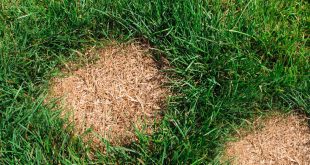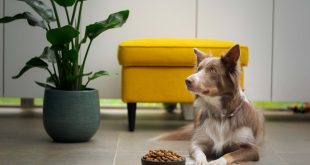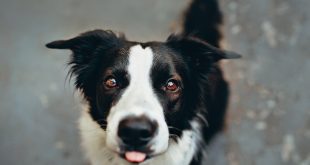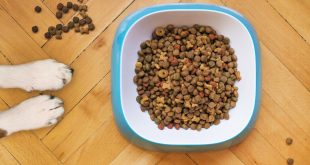This post may contain affiliate links. Please read our disclosure.
It’s a scenario that many pet owners have encountered before – your dog has managed to get its paws on some cat food! But what happens if a dog eats cat food? Is it bad for them, or can they actually benefit from it? Here’s what you need to know about the effects of canine consumption of kitty chow.
Article Contents
What Happens If a Dog Eats Cat Food
It’s not uncommon for a curious pup to take an exploratory bite out of the cat food bowl. After all, it smells so tantalizingly delicious! But what happens if your dog takes more than just a nibble?
If you have a dog that regularly eats cat food, there are several potential consequences. The first is that it may cause digestive issues due to the higher fat content in most commercial brands of cat food. This could lead to vomiting and diarrhea which can be uncomfortable and potentially dangerous for your four-legged friend. Additionally, long-term consumption could cause weight gain or obesity as well as nutritional deficiencies since cats require different levels of vitamins and minerals than dogs do.
To ensure optimal health for both species in the household, it’s best to keep their diets separate by feeding them at different times or placing their bowls far enough apart so they won’t have access to each other’s meals. If necessary you can also use baby gates or litter box partitions to further discourage any unwanted snacking from occurring!
Nutritional Differences between Dog and Cat Food
When it comes to feeding your furry friends, there are some key differences between the food made for cats and that for dogs. Cats need more protein than dogs do, as they require a higher amount of taurine in their diet – an important amino acid found only in animal-based proteins. As such, cat food is generally higher in meat content and lower in carbohydrates than dog food.
In addition to protein needs, cats also have much different dietary requirements when it comes to fat – requiring more of this macronutrient than their canine counterparts. Cat food will include healthy fats from fish oil or vegetable oils while dog foods typically contain animal fat sources like poultry or beef tallow or lard.
Moreover, vitamins and minerals differ greatly between cat and dog diets due to variations in metabolism and digestion abilities across species lines. Cats cannot create certain essential nutrients on their own; therefore their diets must be supplemented with specific ingredients like Taurine – which helps support vision health – B Vitamins – which play a role in digestive health – Arachidonic Acid (AA) – an omega-6 fatty acid essential for skin & coat health – or Vitamin A – necessary for immune system function. Dog foods don’t usually contain these added supplements because they can produce them internally through internal metabolic processes unlike cats who rely solely upon dietary intake of these compounds from outside sources such as petfoods specifically formulated for cats’ unique nutritional needs..
Meanwhile, the opposite is true regarding Calcium levels: Dogs require more calcium supplementation than cats do since puppies grow significantly faster than kittens do during those early stages of life.. Therefore, puppy formulas often come fortified with extra Calcium compared to regular adult maintenance recipes designed primarily with adult size breeds/dogs in mind rather then growth rates associated with smaller breed puppies/dogs .
Ultimately both pets should be provided complete nutrition tailored to each individual’s unique needs whether its based upon age classifications (puppy vs kitten), breed type (smaller versus larger body sizes), activity level(indoor vs outdoor lifestyles) , special medical conditions etc..
Potential Risks of Feeding a Dog Cat Food
Feeding a dog cat food may seem like an easy and convenient way to provide them with their nutritional needs, but it is important to know that there are potential risks associated with this decision.
First of all, the ingredients in cat food are different from those found in dog food, which can lead to health problems if a dog is fed cat food long-term. Cat foods often contain higher levels of proteins and fats than what dogs need for optimal nutrition; these extra nutrients can cause weight gain or digestive upset. Additionally, cats require more taurine than dogs do. Taurine is an essential amino acid that helps keep cats’ hearts functioning properly and aids in vision development; without enough taurine, a canine could develop heart disease or eye problems over time.
Moreover, feeding your pooch too much cat food may also cause vitamin deficiencies as most commercial brands designed for felines lack some of the vitamins needed by pups such as Vitamin A and B12. Vitamins help maintain healthy skin and coat while supporting bone growth; therefore if your pup doesn’t receive enough vital vitamins they will start experiencing weak bones or hair loss due to malnutrition and lack of proper nourishment.
It’s best to stick with traditional kibble specifically formulated for your pet’s size and age range when considering their dietary needs rather than trying something new just because it seems easier or cheaper at first glance – even if it is meant for cats!
Symptoms of Illness in Dogs Who Eat Cat Food
Eating cat food may seem like a harmless habit for your pup, but it’s important to be aware that switching up their diet can have some serious consequences. Dogs who eat cat food are prone to all sorts of gastrointestinal issues and illnesses. If you suspect your dog is eating the kibble meant for cats, there are certain signs and symptoms you should look out for.
The most common symptom of illness in dogs who eat cat food is vomiting or diarrhea. Eating something they’re not used to can lead to an upset stomach and intestinal distress – both of which can cause them discomfort and prevent them from feeling their best. You may also notice changes in their energy levels; if they’ve been lethargic and uninterested in playtime activities they usually enjoy, it could be related to what they’ve been consuming lately.
Other more severe signs include dehydration, loss of appetite, weight loss or gain, weakness/lethargy, increased thirstiness (due to dehydration), bloody stools or vomit, bloating or gas buildup in the stomach area (which may cause pain) as well as bad breath caused by bacteria build-up due to poor digestion habits from eating irregularly-processed foods such as those found in cat food . It’s important that you pay attention these abnormalities because it could indicate underlying health problems stemming from an improper diet..
If any of these symptoms occur after your pup has eaten feline fare it’s important that you take them into see the vet right away so appropriate measures can be taken before further complications arise!
How to Avoid Dogs Eating Cat Food
We all know that cats and dogs don’t always get along, but one thing they both have in common is their love for food. Unfortunately, this can lead to trouble if your dog eats cat food instead of its own. To prevent this from happening and keep your pets safe and healthy, here are some tips for avoiding dogs eating cat food:
First of all, make sure to always store the cat food away from where the dog can reach it – either on a high shelf or inside a cupboard with a secure latch. If you must feed them together at meal times, try not to leave any extra kibble behind; take time afterwards to check that there’s nothing left around for your pooch to pick up! You may also want to consider keeping separate feeding bowls for each pet so that there won’t be any confusion over whose dish belongs to whom.
Another great way of making sure your pup stays away from the kitty’s snacks is by using deterrent sprays or powders around her bowl. Some specifically designed products will create an unpleasant smell or taste which will discourage most dogs without being harmful in any way – just remember not to use anything which could be toxic when ingested by either animal! Finally, training is key; teaching basic commands such as ‘leave’ and ‘drop it’ can help ensure that your furry friends don’t get into mischief while you’re not looking!
The above is just a few tips, but here is a complete guide on how to keep dog from eating cat food.
What to Do if Your Dog Eats Cat Food
If you notice that your pup has helped themselves to a meal of kitty food, it’s important not to panic. Dogs can happily eat cat food without any issues, but if they consume too much of it in one sitting there are some things you should be aware of.
First and foremost, pay attention to the ingredients list on the packaging. Cat food typically contains higher levels of fats and proteins than dog food does so keep an eye out for this information specifically. If your pup has eaten a large quantity, then they may experience digestive distress such as vomiting or diarrhea due to their body having difficulty breaking down these components. In addition, cats have special dietary needs due to their small size so long-term consumption could cause nutritional deficiencies in a larger breed dog.
To avoid any health problems after an accidental snack session with the cat’s dinner bowl:
- Monitor your pet’s behavior closely; watch for signs such as vomiting or diarrhea which indicate digestive upset
- Reduce portion sizes at mealtimes – if needed – until digestion returns to normal
- Make sure that treats are given sparingly
- Consider switching brands if necessary
In conclusion, while eating cat food will not necessarily harm a dog outright – especially when consumed in small quantities – caution is still advised before letting them indulge in their feline friend’s feast more often than usual!
Other Alternatives Instead of Giving Cats and Dogs the Same Diet
When it comes to feeding cats and dogs, the same diet may not be the best option for both. While many pet owners opt for a one-size-fits-all approach when it comes to their furry friends’ diets, different species often require different types of nutrition in order to stay healthy.
If you are unsure about what food is best for your pets, there are some other alternatives that could work instead of giving cats and dogs the same diet. For example, you can look into commercially available natural or organic cat and dog foods that are specifically designed with each species’ nutritional needs in mind. These products contain high quality ingredients like fresh meat, fruits and vegetables which can provide essential vitamins and minerals needed by cats and dogs alike. Additionally, they do not contain fillers or artificial colors which can have adverse health effects over time if ingested regularly.
Another alternative is homemade pet food recipes tailored specifically to cater to individual dietary requirements; this gives more control over what goes into each meal while avoiding potentially unhealthy additives found in store bought options. You can also combine both commercial products as well as homemade dishes if desired – just make sure that whatever you feed your pets meets their specific nutritional needs at all times!
Finally, supplements such as omega 3 fatty acids or probiotics might be beneficial depending on the overall health of your cat or dog; these additions help supplement any dietary deficiencies that may exist due to an inadequate balance of nutrients from regular meals alone.
Wrap up!
In conclusion, it is important to understand the differences between dog and cat food in order to make sure your pet is getting the nutrition they need. Feeding a dog cat food can have some potential risks as cats and dogs have different nutritional requirements. If your dog does accidentally eat cat food, look out for symptoms of digestive upset or other illnesses. The best way to avoid this situation is by keeping their respective foods separate, or opting for an alternative diet that works well for both pets. Lastly, always evaluate pet foods carefully before introducing them into your pet’s diet.
FAQ
What happens if a dog eats cat food?
If a dog eats cat food, it may cause some digestive issues due to the difference in nutritional content. It is best to have separate food bowls for cats and dogs and keep them out of reach from one another.
What is the best way to introduce a new dog into a home with an existing pet?
Slow introductions are key when introducing any animals. Start by keeping them separated but within view of each other so they can become accustomed to each other’s presence before allowing physical contact. Gradually increase their time together until they are comfortable being around one another and no longer showing signs of aggression or fear.
Where should I take my dog if he needs medical treatment?
It is important that you seek veterinary care from a licensed veterinarian for your pet’s medical needs. Your vet will be able to provide guidance on specific treatments as well as advice on how best to care for your pet at home.
How often should I walk my dog?
How often you should walk your dog depends on several factors such as breed, size, health condition, and age; generally speaking however most adult dogs benefit from two walks per day—one during the morning and one in the evening lasting about 20-30 minutes each time depending on their energy levels and preferences.
Can I feed my puppy table scraps?
Although it might seem tempting, feeding puppies table scraps is not recommended because there could potentially be ingredients that are dangerous or unhealthy for their developing bodies; instead stick with specially formulated puppy foods designed specifically for growing puppies which have all necessary nutrients balanced correctly according to their developmental stage.
 Petnile Comprehensive Pet Care Guides
Petnile Comprehensive Pet Care Guides



